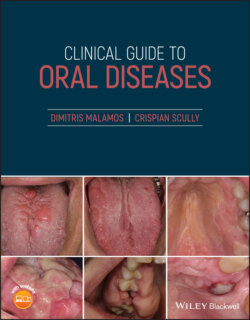Читать книгу Clinical Guide to Oral Diseases - Crispian Scully - Страница 36
3 Brown Lesions
ОглавлениеBrown lesions are commonly seen in the oral mucosa and characterized by accumulations of endogenous or exogenous pigments in the superficial subepithelial connective tissue. These lesions appear as punctuate (macular) or diffuse and have a variety of clinical courses and prognosis (Figure 3.0a and b). Some of them are innocent lesions like racial, physiological mucosal pigmentation or those induced by drugs, diseases like Addison's or syndromes like Peutz‐Jeghers, and others are dangerous like complex nevi or melanomas.
Table 3 shows the most common oral brown pigmented lesions.
Figure 3.0a Brown discoloration of neck skin after radiation.
Figure 3.0b Hydroxyurea‐induced oral brown pigmentation.
Table 3 The most common oral brown lesions.
| In brown oral lesions the pigmentation (exogenous or endogenous) is superficial, while in black or blue lesions is deep into the submucosa |
| Endogenous pigmentation |
| Related to melaninIncreased melanin production onlyRelated to: raceRacial pigmentosaHormone alterationsChloasmaAddison's diseaseEctopic ACTH productionNelson syndromeAcanthosis nigricansLaugier‐Hunziker syndromeLeopard syndromeSpotty pigmentation, myxoma, endocrine overactivity syndromeVon Recklinghausen's diseaseAlbright syndromeUse ofDrugsOral contraceptivesCytostaticsAntimicrobialsAntiarrythmicsFoodsSun exposureFrecklesSolar lentiginesSmokingBetel nut chewingSmoker's melanosisInflammation LP melachrosisBMMP melachrosisEM melachrosisInfections HIVSyndromes Peutz‐Jegher syndrome Abnormal distribution of melanin TumorsBasal cell carcinomasMelanoacanthomaIncreased number of melanocytes Lentigines simplexNeviMelanoma |
| Exogenous pigmentation |
| Foreign materialsTattoosAmalgamGraphiteTribalTarMedicationsLocalPotassium permanganate |
